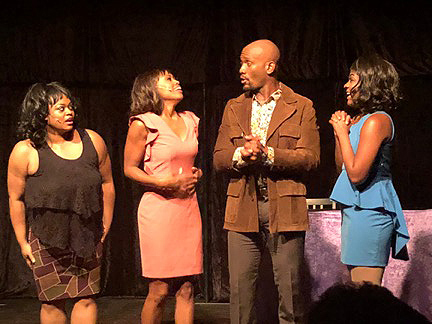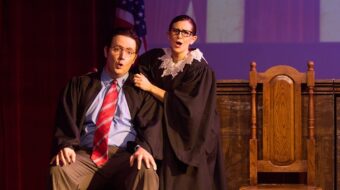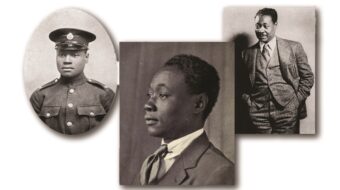
NORTH HOLLYWOOD, Calif.—Director/choreographer Tor Campbell’s rendition of Dreamgirls is an extremely exciting, energetic version and vivid vision of the beloved musical that opened on Broadway in 1981 and onscreen in 2006. With a cast of dozens, the almost three-hour production, with one intermission, pulsates with vibrant dancing, singing and a live musical quartet.
The well-known play appears to be suggested by actual Motown and other major musical acts, in particular the Supremes, here called the Dreamettes, then the Dreams, and finally Deena Jones (the sultry Shaunte Massard) & the Dreams. James “Thunder” Early, aka “Jimmy,” a cross between James Brown with a dash of Little Richard, is played mostly for laughs by the scene-stealing, charming Chad Ra’shun, who provides comic relief and kinetic pyrotechnics.
Among other things, Act I explores how the Civil Rights struggle played out in the music scene during the 1950s and ’60s, as African Americans fight for parity on the stage, disk and screen. There’s a funny vignette depicting how whites (from Elvis to Pat Boone) appropriated and profiteered from Black music, featuring Caucasoid crooner Brian T. Jones. (His “brother from another mother,” Van Jones, recently pointed out in Eugene Jarecki’s documentary The King that Presley not only stole Black music but never supported the Civil Rights movement.) Tellingly, once the Dreams “make it,” performing at Vegas venues and beyond, this leitmotif of how the equal rights cause played out in music is dropped in the second act.
There is a real structural conundrum built into the script (the original book and lyrics are by Tom Eyen) that is, ironically, only accentuated by the fact that Jania Foxworth, a versatile veteran of musical theater, is so abundantly talented as a singer and dancer. Her Effie White (apparently suggested by the Supremes’ Florence Ballard) is the play’s protagonist, but from the moment she steps on stage, she is a profoundly negative person and presence. This characteristic dominates the first act—as Deena tells the overweight Effie, she is “self-indulgent.” As said, Kent is a gifted performer and she plays the role to the hilt. The dramatic problem is that the lead character is so unlikable with annoying, self-destructive traits, making her difficult to watch.

Dreamgirls is also more of an opera than a musical in that there is little spoken dialogue and the characters’ words are more often delivered through song than through speech. The hits just keep on coming: Toe-tapping aficionados of the music are likely to consider this production a bravura tour de force, which others may regard as a torrent of almost nonstop sound that leaves theatergoers little time to catch their breath. The dancing, too, infuses the play with, at times, about 25 cast members strutting their stuff onstage. It’s truly quite a spectacle for the eyes and ears, as well as the heart.
As the title suggests, Dreamgirls is the stuff that Motown dreams are made of. But amidst all of the high stepping and hoopla, Campbell’s version (the original production was choreographed and directed by Michael Bennett) ruminates on the nature of dreams, how people can become fixated upon fantasies to the point of obsessions that ruin real life. As the Berry Gordy-like Curtis Taylor, Apollo Levine’s character, transfixed on his idea of Deena and a new type of sound, embodies this notion. As does Deena, who aspires to be more than a mere entertainer, but a serious artist, making films that matter. Deena realizes she has become like a songbird in a golden cage, frozen into the role that Curtis, the industry, fans and the media have trapped her in.
The outstanding cast is far too large to single out each performer but the lovely Kimberly Ransum-Lundy, who dances, sings and acts in multiple roles, including as a Stepp Sister and dance captain, typified the zest, joy and beauty so many performers brought to this show, enhanced by live music, with Andrew Hudson and Lauralie Pow on keyboards, Ethan Chiampas on bass and Jon Butterworth on drums.
This jumping production is imaginatively, creatively directed and choreographed with great panache by Tor Campbell, who also teaches dance. Tor rendered the choreo for the musical I wrote the book for, Still Standing, which we brought to Switzerland in 2010, and it was inspiring and a sheer joy to experience his artistry once again. During the opening night gala before the curtain rose, Tor, along with Apollo Levine (in addition to portraying Curtis he’s also Dreamgirls’ assistant choreographer), taught theatregoers several dance moves, knowing that the music and movement are so infectious, and urged them to join in at their seats when those songs were played onstage. I’d never ever seen that at a play before.
For a dreamy, red hot act, don’t miss Dreamgirls.
Dreamgirls is being performed Fri. at 8:00 pm, Sat. at 7:00 pm and Sun. at 3:30 pm through September 2 at the Cupcake Theater, 11020 Magnolia Blvd., N. Hollywood 91601. For info: (323)391-3416 or the website here.
Like free stuff? So do we. Here at People’s World, we believe strongly in the mission of keeping the labor and democratic movements informed so they are prepared for the struggle. But we need your help. While our content is free for readers (something we are proud of) it takes money — a lot of it — to produce and cover the stories you see in our pages. Only you, our readers and supporters, can keep us going. Only you can make sure we keep the news that matters free of paywalls and advertisements. If you enjoy reading People’s World and the stories we bring you, support our work by becoming a $5 monthly sustainer today.












Comments